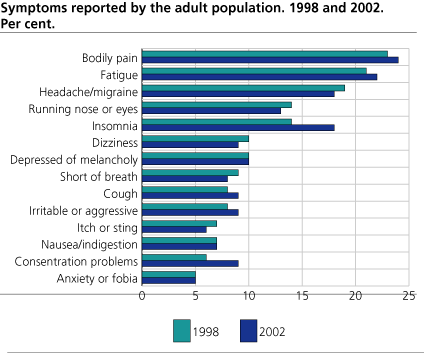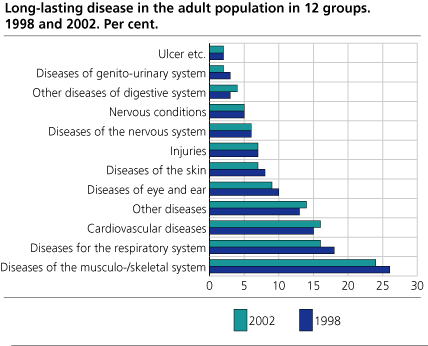Content
Published:
This is an archived release.
Poorer health for young people?
An increasing proportion of elderly people are in good health. But a relatively high and increasing proportion of young people report troubles and symptoms suggesting a more stressful life for these groups.
The fact that four out of five are in good health is an indication of high quality of life for most Norwegians. A large proportion of the population says that their health is good. However, the figure has gone down for young women in 2002 compared to 1998. This does not lead to higher morbidity (reporting of illness), but young people score high on a number of symptoms, such as headache, nausea, melancholy and irritability. It also seems that people who live alone have poorer health and lower vitality (fatigue) compared with people who live with a partner.
More troubles and symptoms among young people
Approximately 57 per cent of the total population say that they had continuous or recurrent symptoms such as bodily pain, headache, suffering from fatigue or insomnia etc in a three-month period, against 56 per cent in 1998. The figure has fallen in older age groups but is slowly increasing in younger age groups. The occurrence of troubles and symptoms is higher for women than men, and for people living alone compared to people living with a partner.
Young men and women (16-24 years) report more symptoms and troubles than earlier, such as difficulty concentrating and sleeping disorders. In addition, higher and increasing proportions of young people feel melancholy or depressed or feel irritable or aggressive. The highest levels for these symptoms are found among young single women. Increasing levels are also seen among women aged 25 to 44 years of age, although not as high as for the youngest age group. Reported psychological symptoms are higher for younger women than older women. The same pattern applies to men, but the proportions are lower in all age groups. Despite the fact that men and women between 45 and 79 years of age do not have more psychological symptoms than others, they have the highest consumption of sedatives, sleeping drugs and medication for depression. From 1998 to 2002 there has been a significant increase in sleeping disorders among women aged 80 years and over. Approximately 16 per cent of this group said that they used sleeping drugs in 2002.
Physical symptoms are most prevalent among men and women over the age of 45. Such symptoms are recurring troubles, such as bodily pain, itching, shortness of breath, dizziness etc. The figures are higher for single people than for couples.
Some illnesses - a lesser burden today?
The prevalence of longstanding illness, injuries and disabilities has increased since the mid-1990s. However, the proportion of people reporting a longstanding illness which limits daily activities to some extent or to a large extent has decreased from 36 per cent in 1995 and 32 per cent in 1998 to 30 per cent in 2002. This applies to all age groups, but is more pronounced among elderly people. Could it be that the illnesses reported in 2002 represent a lesser burden than the ones that were reported in past surveys? Or do new treatment methods and medication make it easier to live with an illness?
Morbidity increases with age, is higher among women than men and is lower among couples than people who live alone. The exceptions are asthma and allergies (respiratory system diseases) where the prevalence is highest in younger age groups. The most prevalent illnesses in the population are found within the groups of musculo-/skeletal diseases (24 per cent), cardiovascular diseases (16 per cent), diseases of the respiratory system (16 per cent). The different morbidity groups are wide and give an impression of prevalence in the population and indicate very general trends. The prevalence of musculo-/skeletal diseases and diseases of the respiratory system have increased among elderly people and that respiratory diseases have increased among men and women in younger age groups.
Find more figures
Find detailed figures for Health, care and social relations, survey on living conditions
Contact
-
Elin Skretting Lunde
E-mail: elin.skretting.lunde@ssb.no
tel.: (+47) 92 42 70 07
-
Jorun Ramm
E-mail: jorun.ramm@ssb.no
tel.: (+47) 92 08 23 99
-
Berit Otnes
E-mail: berit.otnes@ssb.no
tel.: (+47) 45 00 49 34


